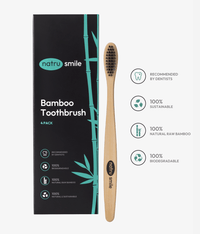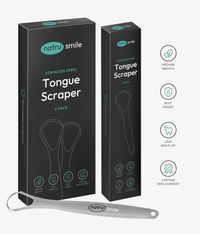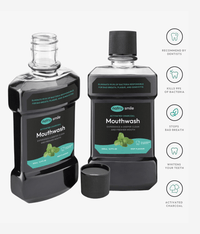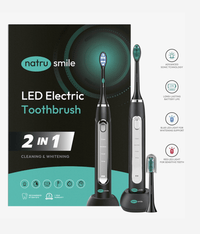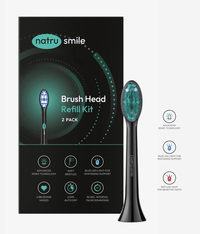
All products are certified by dental expert Dr. Greg Grillo
Veneers are one of the most common cosmetic dental procedures used to enhance your smile. What was once a celebrity beauty trend is now becoming accessible and commonplace for everyday people.
According to dental expert Dr. Khoursh Maddahi, there are three reasons for this emerging trend:
- Gum recession that comes with natural aging
- Natural wear and tear that causes teeth to become discolored
- Damage caused by teeth grinding
Dental veneers can help fix all of the above-mentioned issues, but there are two main types of materials used for this purpose: porcelain and composite.
Each has its own pros and cons, so it’s important to understand them before making a decision.
The Difference Between Porcelain Vs. Composite Veneers
Porcelain and composite veneers are two common materials used in cosmetic dentistry to improve the appearance of teeth. While both enhance teeth aesthetics, they differ in several aspects, including durability, cost, and appearance.
Durability
Porcelain veneers are thin shells made of porcelain that are custom-made to fit over the front of a tooth. They are known for their durability and longevity, with a lifespan of up to 10-15 years or more, with proper care.
Porcelain veneers are also highly resistant to staining. They offer a more natural-looking appearance due to their translucent quality, allowing them to mimic the light-reflecting properties that natural teeth have.
Composite veneers are made of a tooth-colored resin material that is applied to the tooth and shaped by the dentist. They are typically more affordable than porcelain veneers and require less preparation of the natural tooth structure. Composite veneers can also be reversible (snap-on veneers are made of composite resin), so they can be easily removed and replaced if needed.
All of these elements contribute to composite veneers' limited durability compared to porcelain veneers—they typically need to be replaced more frequently (after 5-7 years).
Time
When it comes to the process of getting veneers, porcelain veneers typically require more preparation of the natural tooth structure, as a small amount of enamel must be removed to make room for the veneer.
Porcelain veneers are considered irreversible—the tooth structure cannot be restored once it has been removed. Composite veneers can be placed with minimal tooth preparation, making them a more conservative option time-wise
Aesthetics
Porcelain veneers are considered the gold standard of veneer aesthetics thanks to their ability to mimic the natural translucency and color of teeth. They are also highly customizable, with a wide range of shades and shapes available.
Composite veneers, while still capable of providing a natural-looking appearance, may not offer the same level of customization as porcelain veneers due to their limitations in color and translucency.
Cost
On average, porcelain veneers cost between $900 and $2,500 per tooth. This varies based on several factors, including the location of the dental practice and the type of porcelain used. Composite veneers cost much less—between $250 to $1,500 per tooth—making them an attractive option for those on a budget.
Advantages Of Composite Veneers
Composite veneers offer several advantages that make them a popular choice for cosmetic dental procedures:
-
Affordability: Composite veneers are usually more affordable than porcelain veneers, making them a more accessible option for individuals on a budget.
-
Minimal tooth preparation: Composite veneers require minimal preparation of the natural tooth structure, which means that less enamel needs to be removed than with porcelain veneers. This makes them a more conservative option that preserves the natural tooth structure.
-
Reversibility: Composite veneers are reversible and can be easily removed and replaced if needed. People can also whiten composite veneers, providing peace of mind to those concerned about making irreversible changes to their teeth.
-
Convenience: Patients usually have a much shorter wait time for composite veneers than porcelain ones, as the former can usually be created and applied in just one appointment.
- Versatility: Composite veneers can address a wide range of cosmetic dental issues, including chipped or discolored teeth, gaps between teeth, and misshapen teeth.
Advantages Of Porcelain Veneers
Porcelain veneers also offer several advantages that make them a popular choice for cosmetic dental procedures:
-
Durability: Porcelain veneers are highly durable and can last 10-15 years (or more) with proper care. They are resistant to chipping, cracking, and staining, making them a long-lasting investment.
-
Aesthetics: As long as you choose the right veneer color, porcelain veneers offer a natural-looking appearance that shines like the rest of your smile. Patients customize them to match the surrounding teeth, resulting in a seamless and harmonious smile.
-
Stain resistance: Porcelain veneers are highly resistant to staining, which means they will maintain their original color over time. This is particularly important for individuals who consume staining beverages, such as coffee or red wine.
-
Maintenance: One of the best things about porcelain veneers is that they require no special maintenance beyond regular brushing, flossing, and dental check-ups. This makes them a convenient and low-maintenance option for individuals with busy lifestyles.
- Resilience: Compared to their composite counterparts, porcelain veneers wear and tear and can withstand normal daily activities such as chewing and biting. This means that they can provide long-term benefits without the need for frequent replacement or repair.
Which Is Right For You?
Deciding between porcelain and composite veneers can be a complex decision that depends on several factors, including the patient's dental health, aesthetic goals, and budget.
Here are some factors to consider when choosing between porcelain and composite veneers:
-
Dental health: Patients with severe gum recession or periodontal disease may not be good candidates for veneers, as they require a healthy amount of tooth structure for proper placement. In some cases, gum veneers may be necessary to restore the gum line before veneers can be placed.
-
Aesthetic goals: Patients with significant cosmetic dental issues, such as deep discoloration, uneven teeth, or large gaps, may benefit more from porcelain veneers due to their ability to provide a natural-looking and long-lasting solution. Patients with minor cosmetic dental issues generally find composite veneers to be a more affordable and effective solution.
-
Permanence vs. temporary: Porcelain veneers are considered a permanent solution that requires some tooth structure removal, while composite resin is considered a temporary veneer. that requires minimal tooth preparation. Patients who prefer a reversible and non-invasive solution may prefer composite veneers, while patients seeking a long-lasting solution may prefer porcelain veneers.
-
Budget: Porcelain veneers are generally more expensive than composite veneers, as they require more specialized materials and laboratory time. Patients with a limited budget may find composite veneers to be a more affordable option.
-
Teeth whitening vs. veneers: Patients with minor discoloration may benefit from teeth whitening procedures rather than veneers, as they can provide a more conservative and cost-effective solution.
- Lifestyle: Patients who engage in activities that can cause wear and tear on their teeth, such as teeth grinding or clenching, may benefit more from porcelain veneers due to their durability and resilience.
Ultimately, choosing between porcelain and composite veneers should be made in consultation with a qualified cosmetic dentist. They can thoroughly examine the patient's dental health, discuss the patient's aesthetic goals and lifestyle, and recommend the best course of treatment based on their professional expertise.
Want to learn more? These are the questions our customers ask us the most.
Do Composite Veneers Damage Your Teeth?
Composite veneers do not inherently damage your teeth. They can often be placed with minimal tooth preparation, meaning minimal enamel removal is required in the process. Still, composite veneers can potentially cause damage if they aren't properly cared for. Consulting a qualified cosmetic dentist will help you determine if composite veneers are a good option for your needs.
What Is The Best Type Of Veneer?
The best type of veneers depends on several factors, including the patient's dental health, aesthetic goals, and budget. Porcelain veneers are typically considered the gold standard due to their durability, natural-looking appearance, and resistance to staining. However, composite veneers can provide a cost-effective and minimally invasive solution for patients with minor cosmetic dental issues.
Can You Go Back To Your Normal Teeth After Composite Veneers?
Composite veneers are reversible—they can be easily removed if a patient decides they don't want them anymore. Still, it's essential to note that the natural tooth structure may be slightly altered after removing the veneers, as some enamel may have been removed during placement. It is best to consult with a qualified cosmetic dentist before deciding to have your composite veneers removed.
Do Composite Veneers Change Your Face?
Composite veneers are designed to enhance the appearance of your teeth, which can indirectly affect the overall appearance of your face. As you age, the muscles in your mouth start to lose their elasticity and strength, making it harder for your face to maintain its natural symmetry. Veneers help counteract these effects by supporting those weakened muscles, bringing some definition back into your cheekbones—like a mini facelift.
Who Is Not A Candidate For Composite Veneers?
Patients with significant gum recession, periodontal disease, or insufficient tooth structure may not be good candidates for composite veneers. Patients with severe cosmetic dental issues may also require a more extensive treatment plan, such as porcelain veneers or orthodontics. In less severe cases (e.g., small cavities), dental bonding vs. veneers might be a better option.
Who Is Not A Candidate For Porcelain Veneers?
Patients who are not good candidates for porcelain veneers include those with extensive tooth decay, periodontal disease, or severely eroded enamel. These patients may benefit more from a different type of cosmetic dental procedure—such as dental crowns. Dental crowns vs. veneers should be discussed with a qualified cosmetic dentist.


